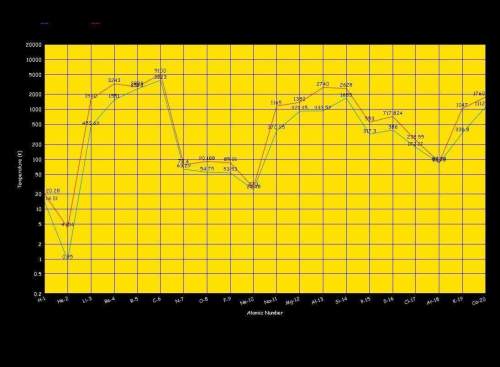
Chemistry, 21.07.2019 23:10 lunarStudios123
Analysis and conclusions
looking at the line plots on your graph, describe how boiling point and melting point vary with respect to atomic number.
now look at the segment of the graph between the two data points marked with black squares. describe how the boiling point and melting point plots behave between these points. be as specific as possible.
on your graph, the data points between the black squares are data for elements with atomic numbers 3 through 9. locate these elements on your periodic table. what term or description would you use to identify these elements with respect to the periodic table?
now look at the green lines you created by connecting the three boiling point data points and the three melting point data points. for each of these lines, describe any trends you see.
locate the elements on your periodic table that you circled in green on your graph. what term or description would you use to identify these elements with respect to the periodic table?
after reviewing your answers to questions 2 and 4 above, would you define boiling point and melting point as a periodic table family trend (vertical groups), period trend (horizontal rows), or neither? explain your answer.
using the room temperature line (orange line) and your periodic table, make lists that identify the state of matter (gas, liquid, or solid) in which each element you plotted exists at room temperature. explain your answers.


Answers: 3


Another question on Chemistry

Chemistry, 21.06.2019 22:30
Joseph has hypothesized that sound travels in waves. if he were following the scientific method, what should he do next? a. ask a question. b. test the hypothesis. c. study the results. d. tell other scientists about his hypothesis.
Answers: 1

Chemistry, 22.06.2019 06:00
One of the few xenon compounds that form is cesium xenon heptafluoride (csxef7). how many moles of csxef7 can be produced from the reaction of 13.0 mol cesium fluoride with 12.5 mol xenon hexafluoride? csf(s) + xef6(s) csxef7(s)
Answers: 1

Chemistry, 22.06.2019 18:30
How many moles of lead are in 1.50 x 10^12 atoms of lead? could you explain the answer as well and not just give it to me i am refreshing for finals and i need to know how to do it
Answers: 3

Chemistry, 22.06.2019 21:00
Write a balanced equation showing the formation of copper (ii) nitrite from its elements
Answers: 1
You know the right answer?
Analysis and conclusions
looking at the line plots on your graph, describe how boiling point an...
looking at the line plots on your graph, describe how boiling point an...
Questions

English, 22.09.2021 02:20



History, 22.09.2021 02:20



History, 22.09.2021 02:30


English, 22.09.2021 02:30

Mathematics, 22.09.2021 02:30

Mathematics, 22.09.2021 02:30

Computers and Technology, 22.09.2021 02:30








Spanish, 22.09.2021 02:30



